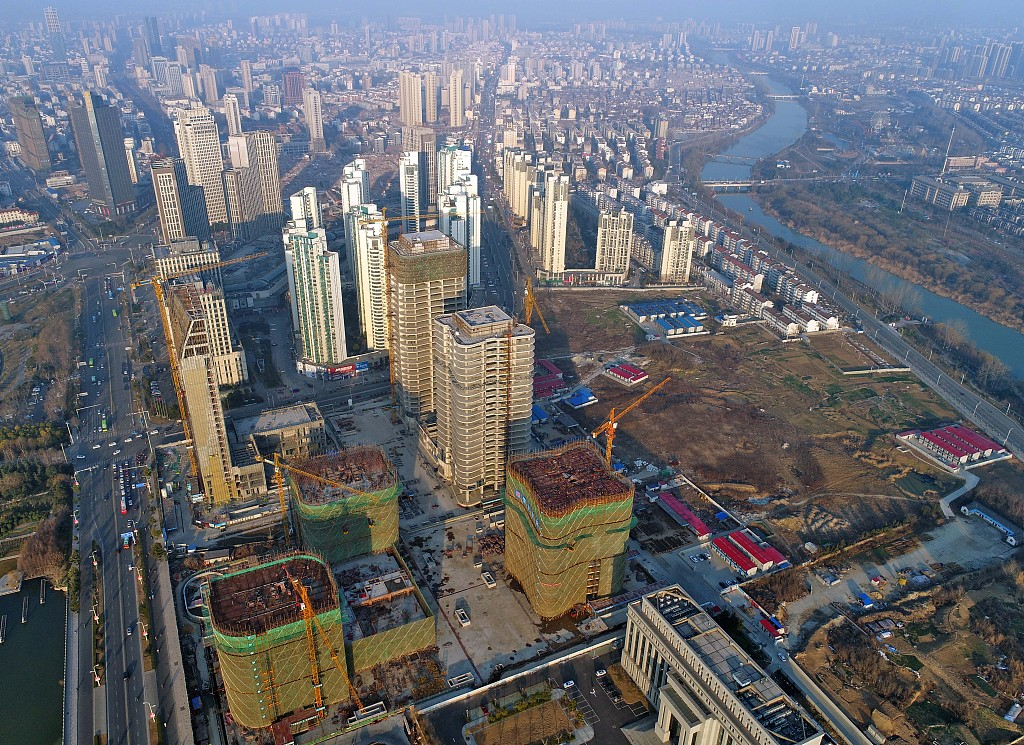

Editor's note: Shi Huimin is an associate professor at School of Economics and a research fellow with the National Academy of Development & Strategy at Renmin University of China. The article reflects the author's opinions, and not necessarily those of CGTN.
China's National Bureau of Statistics released the country's monthly economic figures for May on June 14. Overall, these figures indicate a further slowdown of China's macro economy. However, considering the challenges China faced in May, these numbers are still in a reasonable range.
The fixed-asset investment grew only by 5.6 percent year-over-year, down from April's 6.1 percent. This is mainly because of the slowdown of real estate and infrastructure investment.
Firstly, real estate investment grew by 11.2 percent, which is 0.7 percent smaller than last month. The areas on sale declined by 1.6 percent from the same period a year earlier, while the corresponding number was only 0.3 percent in April.
Although a price rise at the beginning of the year, the real estate investment is expected to slow down further in the year. On the one hand, the real estate sales in the large and medium sized cities are slowing down.
On the other hand, since the plan for the reconstruction of housing units in rundown urban areas is cut and monetary resettlement is reduced, the real estate sales of the third- and fourth-tier cities will be weakened further.
Secondly, the infrastructure investment grew by four percent, down from 4.4 percent. Although a series of policies, such as restraint relaxation of local government financing platform, boost infrastructure investment at the beginning of the year, the growth of infrastructure investment is not steady.

A construction site in China's Jiangsu Province, March 2, 2017. /VCG Photo
Thirdly, the manufacturing investment slightly increased, 0.2 percent up from the previous number in April. Considering the sluggish adjustment, manufacturing investment would slow down further due to global weakening demand and trade war pressure.
Industrial output slow down while the service sector output is solid. In May, the above scale industrial output increased by five percent, down from April's 5.4 percent. Meanwhile, the subcategories of the leading indicator PMI, new orders, input inventory, and employment are below the threshold separating contraction from expansion. They imply that the economy is still weakening.
On the other hand, the service sector is strong, especially the new service industries such as information transport, software, information technology, and lease etc. Due to the structural change, the service sector becomes increasingly important for Chinese economy.
The fast growth of service sector is the source of China's long run growth resilience. Commercial use of 5G technology will push forward China's manufacturing and service growth.
For consumer spending, retail sales grew by 8.6 percent in May, up from April's 7.2 percent. Although the signal is positive, we should be cautious about the holiday effect.
The extension of the Labor Day holiday, from one day to three days, is one reason for better retail sales data. The contribution of consumption to China's economy is increasing.

A waitress works in a Chinese bakery "Chez Blandine" in Beijing, January 30, 2018. /VCG Photo
Expectedly, a series of policies, such as tax cut in income tax and VAT, favorable policies for cars and electronic appliances, will improve the consumption in the future.
Regarding exports and imports, the U.S. dollar denominated exports increased by 2.7 percent in May, while the corresponding number was 2.7 percent in April. The rebound of exports is mainly because of China's exports to the U.S., Japan, ASEAN, South Korea etc.
The imports declined by 8.5 percent, down from four percent in April. The imports decline is mainly because of the slump of bulk commodities and processing trade. The sudden deterioration of China-U.S. trade negotiation may have distorted China's exports data. The U.S. importers may import more Chinese products before the expected tariff hike.
Thus, the exports increase might be only temporary. The decline of imports might truly reflect the downturn of global economy and the negative trend of increasing uncertainty associated with trade conflicts.
Considering the negative shocks happened in May, China's May Economic Data are reasonably fine. More policies, such as tax cut, facilitation of commercial use of 5G, relaxation of car purchase restrictions etc., could counter the negative shocks. These policies are expected to eventually help stabilize the economy.
(If you want to contribute and have specific expertise, please contact us at opinions@cgtn.com.)

Copyright © 2018 CGTN. Beijing ICP prepared NO.16065310-3
Copyright © 2018 CGTN. Beijing ICP prepared NO.16065310-3